|
![Chart 2-13: bar graph showing the answers to the survey question 'What do you think this Icon/Picture means?' [The icon is the plastic material code icon.] (Please check the table for findings.)](../gif/chap2s13.gif)
Table 2-18: What Do You Think This Icon/Picture Means?(%)*
| |
Not Really Sure |
Package Recyclable |
Package is Recycled Material |
Environ-mentally Preferable |
Package Contains
X% Recycled Material |
| Outdoor Pesticide |
37 |
35 |
27 |
10 |
3 |
| Household Cleaner |
39 |
36 |
21 |
12 |
5 |
| Indoor Pesticide |
40 |
33 |
24 |
8 |
4 |
| |
100% Recycled
Material |
Package Not
Recyclable |
Package Made
of Recycled Paper |
Package Made
of Recycled Steel |
No Answer |
| Outdoor Pesticide |
5 |
3 |
1 |
1 |
7 |
| Household Cleaner |
3 |
2 |
2 |
1 |
8 |
| Indoor Pesticide |
4 |
2 |
2 |
1 |
8 |
(Base
= All Respondents)
* Please refer
to Question 9 on the mail questionnaire, Appendix 2-4
26. The symbols with descriptive
language (e.g., "100% Recycled Paperboard") did provide some improvement
in response accuracy. However, the correct response rate was less
than 75% in every case and usually less than 60%.
27. For the HDPE question, there was no answer selection for the
type of plastic from which the package was made. This confounded
the interpretation of responses to that question, since respondents
may have felt compelled to provide some other answer.
28. The demographic groups and other subgroups that demonstrated
more capability for reading and understanding labels identified
the correct responses for these symbols more frequently. These same
consumers also tended to view products bearing these symbols as
environmentally preferable.
|
Implications Regarding Recycling
Claims and Symbols
A. The effectiveness of the tested symbols in communicating
with the general public is not great. However, this seems
to be related to the complexity of the messages carried and
the lack of a compelling motivator to learn.
B. The positive correlation of comprehension with additional
information in the symbol and inferred environmental benefit
indicates that these are motivators for some consumers.
|
Findings on Product Label Signal
Words (Chart 2-14, Chart 2-15, Chart 2-16)
29. Respondents understood that the terms DANGER, WARNING, and
CAUTION characterize a level of risk or personal hazard. They understood
the three terms to be generally relative, with DANGER describing
the highest risk, WARNING a medium risk, and CAUTION a lower risk.
Respondents also perceived the range of risk described by the three
words to start at a medium, rather than at a low, risk level. Even
CAUTION was perceived by over half of the respondents to describe
a lower to moderate level of risk, not a low risk.
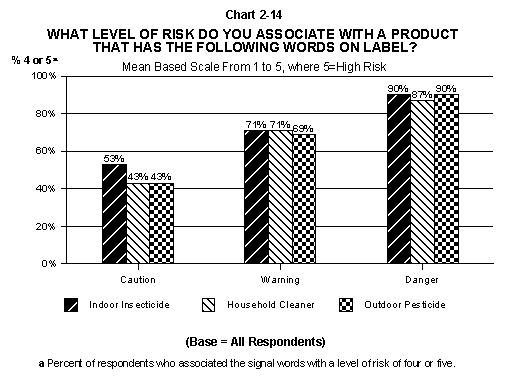

30. None of the respondents mentioned the signal word as one of
the things they use to determine the possible harmful effects of
a product.

31. Just under half of respondents agreed either completely or
somewhat that the words CAUTION, WARNING, and DANGER on a product
mean the same thing to them.
|
Implications Regarding Signal
Words on Product Labels
A. Consumers do not understand the EPA's purpose for using
signal words.
B. All three words convey some level of concern.
|
Findings on Respondents' Sources
of Information and Education (Chart 2-17, Table 2-19)
32. Besides the packaging, respondents identified the top sources
to which they referred for product information to be (see Chart
2-17):
- Indoor insecticides -- store displays, TV ads, friends/family/co-workers,
product brochures, and magazine ads;
- Outdoor pesticides -- store displays, product brochures, friends/family/co-workers,
store salespersons, and TV ads; and
- Household cleaners -- TV ads, friends/family/co-workers, store
displays, magazine ads, product brochures;
33. One in five outdoor pesticide users would contact a university
or county extension service for more information about a product.

Table 2-19: Besides Packaging Where Else Do You Get Information About the Products You Use? (%)
| |
Newspapers/
Magazines |
At
Store |
TV |
Friend/
Family/
Coworker |
Brochure |
Manufacturer |
University Extension |
| Outdoor Pesticide |
54.7 |
69.7 |
49.1 |
44.4 |
44.7 |
16.8 |
17.0 |
| Household Cleaner |
65.8 |
47.5 |
66.3 |
55.9 |
32.7 |
14.7 |
3.0 |
| Indoor Pesticide |
55.8 |
53.0 |
49.6 |
38.0 |
37.6 |
17.9 |
11.8 |
| |
Poison
Control |
Environmental
Group |
Consumer
Group |
Government
Agency |
Library |
Internet/
Web |
| Outdoor Pesticide |
7.4 |
7.6 |
7.0 |
10.3 |
5.9 |
5.4 |
| Household Cleaner |
5.3 |
5.6 |
7.2 |
2.2 |
3.1 |
3.0 |
| Indoor Pesticide |
11.6 |
7.0 |
7.0 |
5.1 |
6.0 |
5.8 |
(Base = All
Respondents)
|
Implications Regarding Respondents'
Sources of Information and Education
A. Consumer education and information efforts should design
and deliver to the sources that people use.
B. Consumers expect to get information through traditional
means, rather than seeking it through companies or the government.
C. Extension agents are also a target audience for the consumer
education program.
|
Findings on Ingredients Information
(Chart 2-18, Chart 2-19, Chart 2-20, Chart 2-21, Table 2-20)
34. Approximately 90% of the telephone survey respondents were
able to find and properly identify the ingredients/contents section
of the label for all three product categories. The ability to find
this section on the cleaners label, however, was significantly lower
than on the other labels. Demographic subgroups did not show any
surprising subgroup trends in their ability to find this label section.
35. After trying to find various sections during the phone survey,
nearly 90% of the respondents stated that label information was
positioned where they expected it to be. There were statistical
differences among all categories, with satisfaction being greatest
with outdoor pesticide and poorest with cleaners, although cleaners
still received an 87.6% affirmative response. Of the specific requests
for change, the highest was "ingredients should be on the back label."
However, only 2 to 4% of all respondents voiced that request.
36. In all three product categories, of those respondents who never
read the ingredients section (approximately 25% for all categories),
an unusually high percentage of them did not read it because they
did not understand the information in the section.
37. When asked if they look for ingredient information, approximately
40% responded affirmatively for the household cleaner and indoor
insecticide product categories, but a statistically higher percentage
(48%) answered "yes" in the outdoor pesticide category. The most
prominent reason for reading this section was product comparison.
However, approximately 15% claimed concern for health of a family
member; this was higher (and the difference statistically significant)
for indoor pesticide and household cleaners.
38. In all three product categories, few survey respondents specified
a label change request, but the highest response (~3%) was "list
all ingredients."
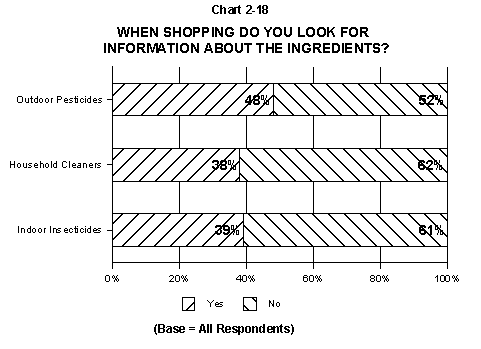
Table 2-20: Why Do You Look for Information about Ingredients?
Indoor Insecticide
(n=343) |
Household Cleaner
(n=338) |
Outdoor Pesticide
(n=408) |
| I want to compare different products
66% |
I want to compare different products
64% |
I want to compare different products
57% |
| I or another household member
want to avoid using certain chemicals because of allergies or
other health related reasons 41% |
I or another household member
want to avoid using certain chemicals because of allergies or
other health related reasons 47% |
I'm looking for the name of a
specific ingredient 30% |
| I'm looking for the name of a
specific ingredient 38% |
I'm looking for the name of a
specific ingredient 25% |
I or another household member
want to avoid using certain chemicals because of allergies or
other health related reasons 27% |
| I want to know the scientific
names of the ingredients 22% |
I want to know the scientific
names of the ingredients 16% |
I want to know the scientific
names of the ingredients 14% |
(Base = All
Respondents Who Said They Look for Ingredient Information
While Shopping)
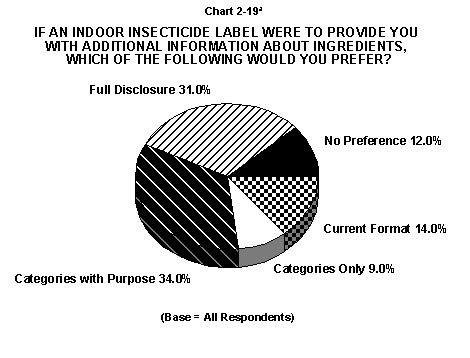
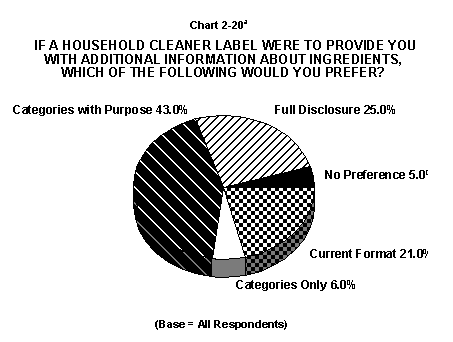
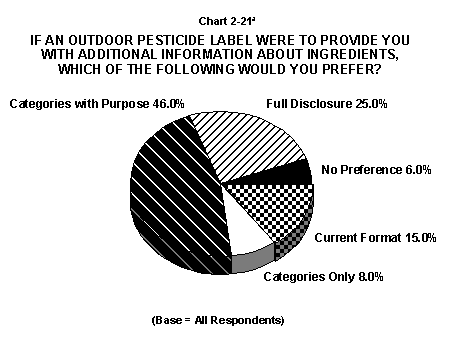
a (For charts 2-19, 2-20,
and 2-21) Please refer to Question 4c in the mail questionnaires
in Appendix 2-4.
39. When given a choice of "ingredients" formats, three out of
four respondents chose less than full disclosure (providing names
and % of all ingredients). Options listing categories of ingredients
along with a description of the purpose of the ingredients were
preferred.
40. One in eight respondents used the ingredient statement to determine
possible harmful effects from the ingredients listed.
41. In each of the three product categories, the phrase "other
ingredients" was not fully understood.
42. "Ingredients" was ranked seventh among sections for importance,
but well below the top six in all three product categories. It was
also infrequently cited as a section to be found most easily.
43. The label preference for the ingredients section of the FIFRA
vs. non-FIFRA cleaners label was comparable to the overall preference
(58% favoring FIFRA) and the highest preference for FIFRA labeling
of the individual sections tested.
|
Implications Regarding Ingredients
Information on Product Labels
A. Characteristics of the cleaner label make it somewhat
more difficult to find the contents statement on that label.
Cleaners are perceived to be inherently different than pesticides.
B. Consumers are likely to be satisfied with current placement
of ingredients if the format and purpose of this section are
clear.
C. Consumers do not know how to use the ingredients statement
as currently presented.
D. Ingredients are easier to find and read in tabular form
on the front label panel.
E. While a small group of people have a strong desire for
full ingredient disclosure on labels, full disclosure is not
required to meet the needs most consumers cite for ingredient
information.
F. Ingredients are sometimes relied upon as a surrogate for
hazard information.
|
Findings on Respondents' Attitude
Toward Product Categories
The following table captures reactions to consumer values in the
attitude battery for each of the three product categories. (Please
refer to question 11 in the indoor insecticide and outdoor pesticide
mail questionnaires and question 12 in the household cleaner mail
questionnaire in Appendix 2-4.)
ATTITUDE BATTERY KEY
- Number on top left of each cell indicates percentage of respondents
who said they "agree completely" with the statements given.
- Number on top right of each cell indicates percentage of respondents
who said they either "agree completely" or "agree somewhat" with
the statements given.
- Number in the middle center of each cell indicates the deviation
from the mean. The higher the deviation, the more strongly the
attitude is held.
- [Brackets] indicate a negative deviation from the mean.
Table 2-21: Statements Regarding Respondents' Attitude Toward Product Categories
| Statement |
Indoor
Insecticide |
Household
Cleaner |
Outdoor
Pesticide |
| It
is important that the packaging tell me how soon I/my children/pet
can re-enter the treated area |
- |
- |
65.4
93.5
1.56
|
| Labels
should say whether the product should not be used by or around
pregnant women |
60.2
89.5
1.46
|
53.5
85.2
1.34
|
56.2
87.2
1.38
|
| The level of harmful effects of a product plays a role in deciding
which product I purchase |
49.2
82.3
1.26
|
35.2
77.0
1.05
|
44.0
81.7
1.19
|
| It
is important to know the minimum time before I can safely re-apply
the product |
38.2
86.0
1.20
|
- |
- |
| I
know how to use so there is no need to read the label |
1.6
12.1
[1.02]
|
1.6
12.8
[0.86]
|
0.6
4.7
[1.31]
|
| Using
product safely is common sense |
40.2
83.2
1.10
|
40.8
84.3
1.14
|
32.9
78.3
0.91
|
| The
more product I use at a time, the more effective it will be |
1.3
8.4
[1.03]
|
0.8
8.4
[0.93]
|
0.7
7.5
[1.05]
|
| No
need to worry about storage if CR closure is used |
4.1
14.7
[1.00]
|
7.6
19.1
[0.79]
|
3.6
11.0
[1.18]
|
| Unused
product should be disposed down the drain |
4.6
11.1
[1.08]
|
20.3
46.6
0.23
|
1.6
3.0
[1.54]
|
| I
know what to recycle so I don't need to read the label |
3.1
10.9
[0.91]
|
2.5
16.7
[0.66]
|
1.3
7.0
[1.08]
|
| I
don't worry about chemicals in products |
5.0
17.9
[0.92]
|
4.0
22.4
[0.66]
|
3.2
16.5
[0.94]
|
| Would
like information on long term effects on label |
32.6
71.9
0.95
|
25.1
58.6
0.66
|
30.1
67.5
0.87
|
| I
always purchase the least harmful product |
32.1
67.2
0.86
|
25.4
57.7
0.65
|
34.3
68.4
0.89
|
| It
is more important to me to know which ingredients might be more
harmful than how effective they are |
31.6
68.5
0.81
|
- |
27.6
63.7
0.69
|
| Peel
open label has more information than flat label |
- |
- |
26.6
65.5
0.80
|
| Repeat
as necessary means reapply as soon as see bugs |
26.9
69.1
0.76
|
- |
- |
| Overall
satisfaction with current label information |
15.2
68.7
0.73
|
11.4
64.8
0.64
|
10.1
64.4
0.62
|
| I
feel more comfortable if all ingredients are listed |
26.9
52.8
0.58
|
24.4
55.2
0.60
|
27.4
57.9
0.63
|
| Need
more information on how much or how long to apply for desired
result |
17.9
57.9
0.56
|
- |
- |
| For
disposal, I rely more on experience than the label |
5.3
26.4
[0.45]
|
6.6
35.4
[0.19]
|
1.9
17.7
[0.84]
|
| For
use, I rely more on experience than label |
5.7
29.8
[0.31]
|
7.2
43.0
0.05
|
1.5
14.7
[0.86]
|
| It
is necessary to wrap in paper before disposal |
17.3
35.6
0.14
|
5.7
16.1
[0.51]
|
19.3
47.9
0.46
|
| Easy
to find product information I need |
12.7
59 .5
0.52
|
11.6
57.1
0.50
|
10
7 53.8
0.40
|
| Information
on the label is hard to understand |
10
8 49.2
0.24
|
8.2
44.7
0.20
|
13.0
57.5
0.46
|
| The
government insures the product is safe to use |
7.4
36.3
[0.10]
|
5.7
27.0
[0.32]
|
3.8
25.8
[0.40]
|
| If
I can buy in trusted store, the product must be safe to use |
15.3
36.8
[0.08]
|
12.6
30.8
[0.22]
|
9.5
25.5
[0.40]
|
| Fewer
possible harmful effects means poorer performance |
4.0
26.9
[0.24]
|
2.3
16.2
[0.48]
|
7.2
39.1
0.12
|
| I
read labels because a household member has allergy/ health problem |
19.1
34.8
[0.15]
|
13.4
28.2
[0.34]
|
12.1
27.1
[0.35]
|
| Disposal
instructions on the label don't agree with my community |
3.6
15.9
[0.29]
|
2.2
22.0
[0.12]
|
3.1
15.0
[0.31]
|
| It's
OK to open the peel open label in the store |
- |
- |
23.7
48.4
0.29
|
| The
manufacturer assures product safety |
11.6
38.4
0.03
|
10.2
38.3
[0.02]
|
6.3
29.8
[0.30]
|
| I
don't need complete listing of ingredient Information; I don't
understand it anyway |
12.4
41.7
[0.03]
|
8.3
37.3
[0.10]
|
8.4
34.9
[0.25]
|
| Environmental
or natural products often don't work well |
6.0
40.0
0.08
|
3.5
29.6
[0.14]
|
6.0
36.2
0.03
|
| CAUTION/
WARNING / DANGER all mean the same thing to me |
16.2
48.4
0.07
|
15.9
49.0
0.11
|
13.9
44.0
[0.06]
|
Findings are as follows:
44. The highest response to attitude questions was for personal
health and safety information and for instructions, especially those
associated with safe use.
45. The consumer attitude toward household cleaners was different
from attitudes toward the other two product categories. Significant
differences were found from both indoor insecticides and outdoor
pesticides in about 60% of the questions, and at least one other
category in about 95% of the questions common to all categories.
46. In approximately two-thirds of the questions common to indoor
insecticides and outdoor pesticides, there was a significant difference
in attitudes between those two product categories.
47. The largest numerical differences in response were those for
down the drain disposal, knowing what to recycle without label assistance,
and greater reliance on experience than label information for either
disposal or use. In each case, respondents showed much less concern
and/or greater familiarity for household cleaners.
48. Respondents understood that cleaners may be disposed of down
the drain but indoor insecticides and outdoor pesticides should
not be.
|
Implications Regarding Respondents'
Attitudes Toward Product Categories
A. Household cleaners are perceived to be lower risk than
pesticides in both use and disposal. Consumers are much more
familiar with these products and are less likely to read the
label for information.
B. Indoor insecticides are more familiar to respondents than
outdoor pesticides so the comfort level in using those products
is greater. However, the indoor usage is associated with greater
concern about health effects.
C. Consumers want specific information on use of these products
so they can assure personal, family, and pet safety while
getting the desired performance.
|
Findings on Germ Killing Potential
Information
49. Respondents were asked to rank, from high to low, the germ
killing potential of each of the following terms: deodorizer, cleaner,
sanitizer, anti-bacterial, and disinfectant. Respondents indicated
the germ killing power of each individual term, and generally ranked
all the terms in the correct order. The exception, however, was
that respondents saw "anti-bacterial" as having more germ killing
potential than either disinfectants or sanitizers, when, in fact,
"anti-bacterial" refers to any product which kills bacteria.
50. When asked on the phone survey to define "disinfection," over
80% of respondents answered correctly.
Findings on Product Category Comparisons
51. The labels of household cleaners are less completely read than
those of indoor insecticides and outdoor pesticides. Fewer consumers
routinely read any section of the label on cleaners except the brand
name.
52. For household cleaners label readers:
- Brand name is of higher importance, and
- Health and safety information of lower importance.
53. For all sections of the label, the indoor insecticide product
label was found to be more effective in communicating the right
amount of information with a greater specificity.
- Active and Other Ingredients -- indoor insecticide better
than both household cleaner and outdoor pesticide,
- Directions for Use -- indoor insecticide better than
outdoor pesticide and much better than cleaner,
- Storage and Disposal -- outdoor pesticide worse than
either indoor insecticide or household cleaner,
- Precautionary Statements -- both indoor insecticide and
outdoor pesticide better than household cleaner, and
- First Aid -- both indoor insecticide and household cleaners
better than outdoor pesticide.
54. About twice as many consumers had purchased cleaning products
as had purchased either indoor insecticides or outdoor pesticides.
55. Many more consumers disposed of unwanted household cleaning
products and/or containers by rinsing out, pouring down the drain,
throwing in the trash unwrapped, and recycling. The indoor insecticide
and outdoor pesticide products and containers were wrapped before
being placed in trash much more than household cleaners were.
Implications Regarding Product
Category Comparisons
A. Household cleaners have greater familiarity and lower perceived
risk for consumers. This results in more purchasing by brand name
and less label reading. The most effective labels are on indoor
insecticides, possibly because these labels are routinely read by
consumers with a higher level of concern.
|
![[logo] US EPA](../gif/logo_epaseal.gif)
![Chart 2-13: bar graph showing the answers to the survey question 'What do you think this Icon/Picture means?' [The icon is the plastic material code icon.] (Please check the table for findings.)](../gif/chap2s13.gif)







